Help with inside watering for ficus Alii tree
caroli
11 years ago
Related Stories

TREESHow to Use Trees Inside
Bring nature close by integrating the beauty of trunks and trees — even smaller leafy trees — into your home
Full Story
INSPIRING GARDENSInside Houzz: A Waterfront Property Ditches the Grass for a Garden
New drought-tolerant plantings and outdoor gathering spaces help this California backyard take in the view without wasting space or water
Full Story
GARDENING GUIDESHow to Keep Your Trees Healthy
Ensure your trees’ vigor for years to come with these tips for protecting roots, watering effectively and more
Full Story
CONTAINER GARDENSContainer Garden Basics: How and When to Water Potted Plants
Confused about soil moisture, the best time to water and what watering device to use? This guide can help
Full Story
HOUZZ TOURSMy Houzz: Saturated Colors Help a 1920s Fixer-Upper Flourish
Bright paint and cheerful patterns give this Spanish-style Los Angeles home a thriving new personality
Full Story
PETS6 Ways to Help Your Dog and Landscape Play Nicely Together
Keep your prized plantings intact and your dog happy too, with this wisdom from an expert gardener and dog guardian
Full Story
MOST POPULAR7 Ways Cats Help You Decorate
Furry felines add to our decor in so many ways. These just scratch the surface
Full Story
BATHROOM WORKBOOKStandard Fixture Dimensions and Measurements for a Primary Bath
Create a luxe bathroom that functions well with these key measurements and layout tips
Full Story
LIFE12 House-Hunting Tips to Help You Make the Right Choice
Stay organized and focused on your quest for a new home, to make the search easier and avoid surprises later
Full Story





greenlarry
flora_uk
Related Discussions
Help, save my baby! (Ficus Alii)
Q
Tapla...my poor Ficus 'Alii' + my hubby = :-(
Q
Help! Massive leaf loss in 10 ft Alii Ficus
Q
Droopy Ficus Alii: used to be braided, but now...
Q
tapla (mid-Michigan, USDA z5b-6a)
caroliOriginal Author
tapla (mid-Michigan, USDA z5b-6a)
caroliOriginal Author
caroliOriginal Author
greenlarry
caroliOriginal Author
caroliOriginal Author
tapla (mid-Michigan, USDA z5b-6a)
caroliOriginal Author
tapla (mid-Michigan, USDA z5b-6a)
caroliOriginal Author
tapla (mid-Michigan, USDA z5b-6a)
caroliOriginal Author
tapla (mid-Michigan, USDA z5b-6a)
greenlarry
tapla (mid-Michigan, USDA z5b-6a)
caroliOriginal Author
tapla (mid-Michigan, USDA z5b-6a)
caroliOriginal Author
greenlarry
caroliOriginal Author
greenlarry
tapla (mid-Michigan, USDA z5b-6a)
rina_Ontario,Canada 5a
greenlarry
tapla (mid-Michigan, USDA z5b-6a)
caroliOriginal Author
caroliOriginal Author
tapla (mid-Michigan, USDA z5b-6a)
marcia1962
caroliOriginal Author
greenlarry
tapla (mid-Michigan, USDA z5b-6a)
caroliOriginal Author
tapla (mid-Michigan, USDA z5b-6a)
caroliOriginal Author
tapla (mid-Michigan, USDA z5b-6a)
caroliOriginal Author
tapla (mid-Michigan, USDA z5b-6a)
caroliOriginal Author
caroliOriginal Author
tapla (mid-Michigan, USDA z5b-6a)